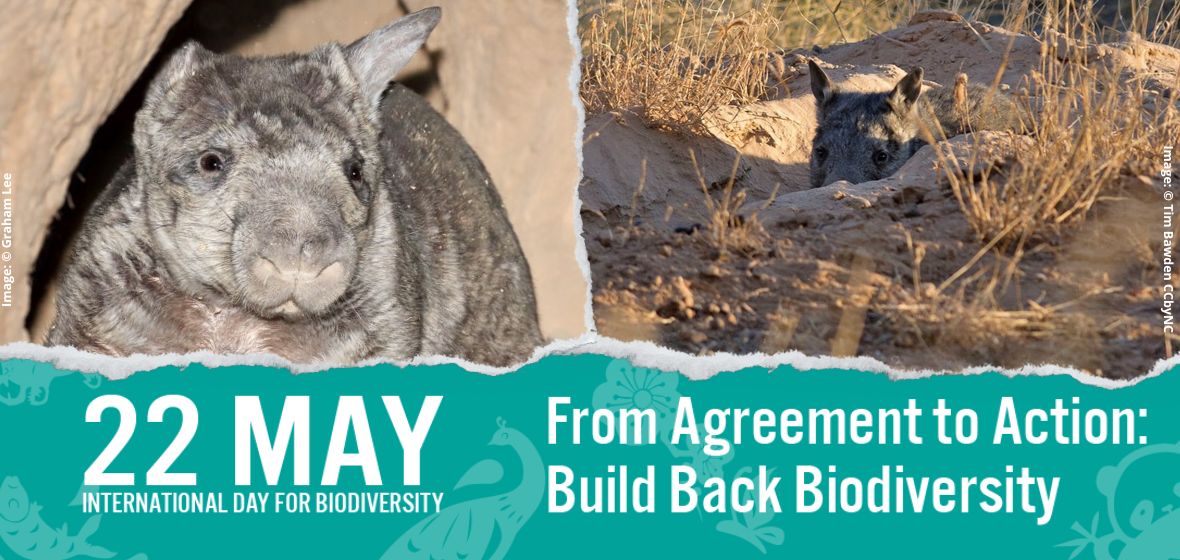
19 May 2023
As we approach the International Day for Biological Diversity on 22 May 2023, with the theme “Agreement to Action: Build Back Diversity”, it is important to recognise the significance of digging mammals in preserving Queensland’s rich biodiversity.
Biological diversity refers to the wide variety of plants, animals, and microorganisms in an ecosystem. However, biodiversity also includes genetic differences within species and the environment where they interact.
Diversity is vital for sustaining our civilisation. Plants and animals provide nutrition, while traditional plant-based medicines are crucial for healthcare, especially in rural areas of developing countries. Importantly, intact biodiversity acts as a defence against zoonotic diseases like coronaviruses.
Threats to Queensland’s biodiversity
Despite recognising biodiversity as a global asset, human activities have significantly reduced the number of species worldwide. Australia compares internationally as the second highest-ranked country for biodiversity loss. Queensland, however, has the highest biodiversity of any state in Australia.
In Queensland, habitat loss, invasive species, diseases, inappropriate fire regimes, illegal wildlife trade, pollution, and climate change pose significant threats to the state’s biodiversity. Land clearing, in particular, has had a devastating impact on the state’s wildlife, endangering species and leading to some extinctions.
Between 2007 and 2022, the number of species listed as threatened in Queensland increased by 97 animals and 244 plants (1). As at 30 April 2022, there were 1048 threatened species (255 animals and 793 plants) listed as threatened in Queensland alone (2)
Digging mammals enhance biodiversity
Charles Darwin first examined the significance of digging mammals in influencing environments in the late 1800s. He highlighted how seemingly insignificant organisms could have impacts that ultimately transform landscapes.
Today, researchers continue to shed light on the engineering role of fauna, particularly digging mammals. These mammals, such as wombats, bilbies, bandicoots, potoroos and echidnas, play a crucial role in maintaining the health of Queensland’s environments.
“Digging mammals can positively influence biodiversity when they create burrows and forage for food,” said Wildlife Queensland Projects Manager Matt Cecil.
“Their digging helps ecosystem processes such as soil turnover, litter decomposition and plant growth.”
Northern hairy-nosed wombat (Lasiorhinus krefftii)
One of Queensland’s digging mammals, the northern hairy-nosed wombat, is listed as critically endangered in Queensland under the Queensland Nature Conservation Act 1992 and nationally under the Commonwealth Environment Protection and Biodiversity Conservation Act 1999.
This wombat stands out as one of the most endangered animals on Earth as its preferred habitat, open eucalypt woodland, has been significantly cleared. Other challenges northern hairy-nosed wombats face include competition with livestock, rabbits and predation by dingoes and wild dogs.
The wombat almost became extinct in the 1980s when numbers plummeted to 30 at the Epping Forest National Park. The first translocation of northern-hairy-nosed wombats from Epping to Richard Underwood Nature Refuge happened in 2009, and it is believed that about 350 wombats now live between the two sites (3).
Digging mammals, such as northern hairy-nosed wombats, are integral to Queensland’s biodiversity. As we celebrate the International Day for Biological Diversity, it’s time to value and protect digging mammals and their habitats to help restore biodiversity for future generations.
Wildlife Queensland continues to fight for threatened species by influencing the government to strengthen environmental laws and outcomes, mapping species distribution and habitats, holding community awareness-raising events, and conducting revegetation, weed removal and invasive pest management programs. If you’d like to support our work, please DONATE.
More information
Check out Wildlife Queensland’s resource section on our website to read more about Queensland’s wildlife species, including the fascinating northern hairy-nosed wombat.
If you’d like to read more about our conservation work with Queensland’s more common digging mammal, the echidna, please read our program page. If you’re lucky to spot an echidna, please report your sighting here.
Notes:
- https://www.qld.gov.au/__data/assets/pdf_file/0015/222081/queensland-biodiversity-conservation-strategy.pdf
- https://www.qld.gov.au/environment/plants-animals/conservation/threatened-wildlife/threatened-species/explained
- https://www.qld.gov.au/environment/plants-animals/conservation/threatened-wildlife/threatened-species/featured-projects/northern-hairy-nosed-wombat/about-northern-hairy-nosed-wombats
